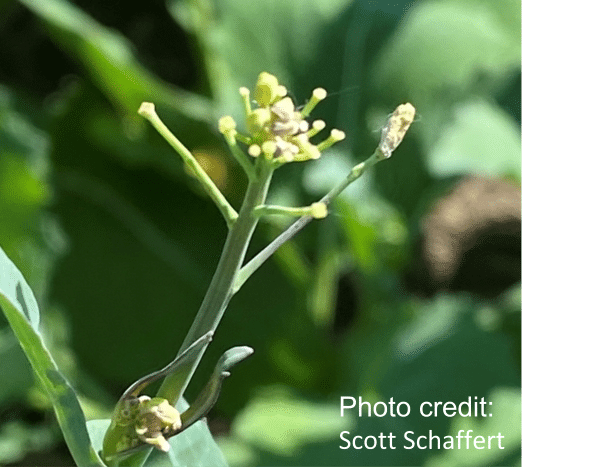Sclerotinia risk is building
Sporadic moisture across much of the prairies and a quickly growing canopy mean sclerotinia may threaten many acres soon. Sclerotinia is canola’s costliest disease. An easy way to predict yield loss is to halve the plant incidence: if 10% of plants show symptoms, expect yield loss in the range of 5%.
Since fungicide application must occur before disease symptoms are evident, in-field scouting, careful risk assessment and correctly timing fungicide application are critical. Although spores can travel long distance, the disease is primarily driven by spore production in-field, so keep a watchful eye on canopy humidity and coming precipitation. Prepare now to be ready to spray as soon as necessary: the spray window closes very quickly. Unless the field is definitely high risk and must be entirely sprayed, leave a check strip to assess control later in the season. (Sclerotinia fungicide timing) (Sclerotinia spray decision) (Precipitation map)
Insect update: lygus bugs
Most insect pests have clearly defined action thresholds based on the insect’s abundance at a specific crop growth stage. The most vulnerable crop stage for lygus feeding is after flowering and when seeds are enlarging on lower pods. In cage studies, bolting or budding canola shows no yield penalty from lygus feeding, likely because the crop compensates with additional flowers. An economic threshold can’t be determined without a predicted yield loss; therefore, a threshold at bolting is not required. That said, very high lygus bug numbers (well in excess of 20-30 per 10 sweeps), where multiple lygus are present on each flower cluster, may cause significant numbers of aborted blossoms or missing pods. Additional information on lygus scouting and timing is available here. Keep in mind that problems in the crop (aborted flowers, lack of flowering, etc.) may coincide with but not be caused by the presence of a few lygus bugs now. (Canola Encyclopedia: lygus bugs)
Insect update: grasshoppers
Grasshoppers are being reported in cereal and lentil fields from Alberta through Manitoba and may move into some canola fields soon. If pest pressure of all kinds is high throughout the season, control options may be limited later in the season because of MRL concerns and repetitive use restrictions. This may be a year to consider incorporating alternative insecticide options such as Eco Bran, a targeted bait that protects beneficials and offers a different mode of action than other products. Early control pays: nymphs need to ingest 1/8 of the active ingredient (carbaryl) compared to adults. Scout carefully as recent rains may have significantly reduced grasshopper nymph infestations on a field by field basis. Note that the current high price of canola may change producers’ action threshold. See the 2022 Crop Protection Guide for additional details and product options. (Grasshopper forecast maps: Alberta | Saskatchewan | Manitoba) (Canola Encyclopedia: grasshoppers) (Manitoba Agriculture: Grasshopper fact sheet)

What’s wrong with that crop?
An unusually high number of producers are reporting a poor and patchy crop, lack of flowering and/or missing pods this season. A less-than-ideal stand is challenging anytime but is particularly painful when canola prices are high. Be a student of the crop: scout above and below ground to try to identify the problem, both to decrease its impact this year (where possible) and to mitigate the issue in another year. Luckily, the season is far from over. Canola has the ability to bounce back remarkably. Therefore, proactively manage all that is still manageable (weeds, pests, disease, fertility) to maximize this season’s yield. (The scouting toolkit) (8 reasons for missing pods) (Agronomy steps to make an accurate diagnosis)

